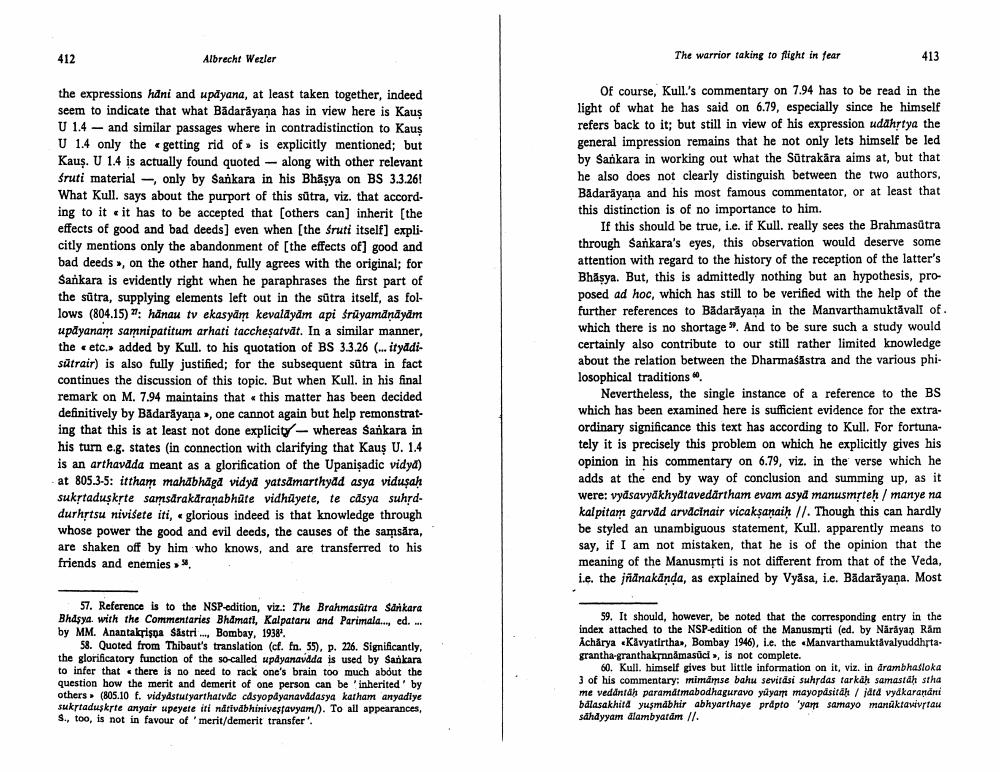________________
412
Albrecht Wezler
the expressions hani and upayana, at least taken together, indeed seem to indicate that what Badarāyaṇa has in view here is Kaus U 1.4 and similar passages where in contradistinction to Kaus U 1.4 only the getting rid of is explicitly mentioned; but Kaus. U 1.4 is actually found quoted along with other relevant Śruti material, only by Sankara in his Bhasya on BS 3.3.26! What Kull. says about the purport of this sutra, viz. that according to it it has to be accepted that [others can] inherit [the effects of good and bad deeds] even when [the śruti itself] explicitly mentions only the abandonment of [the effects of] good and bad deeds», on the other hand, fully agrees with the original; for Sankara is evidently right when he paraphrases the first part of the sutra, supplying elements left out in the sutra itself, as follows (804.15): hanau tv ekasyam kevalāyām api śrüyamāṇāyām upāyanam samnipatitum arhati taccheṣatvät. In a similar manner, the etc. added by Kull. to his quotation of BS 3.3.26 (... ityādisūtrair) is also fully justified; for the subsequent sutra in fact continues the discussion of this topic. But when Kull. in his final remark on M. 7.94 maintains that this matter has been decided definitively by Badarāyaṇa», one cannot again but help remonstrating that this is at least not done explicity- whereas Sankara in his turn e.g. states (in connection with clarifying that Kaus U. 1.4 is an arthavada meant as a glorification of the Upanisadic vidya) at 805.3-5: ittham mahābhāga vidya yatsämarthyäd asya viduṣaḥ sukṛtaduşkṛte samsarakāraṇabhüte vidhuyete, te casya suhṛddurhṛtsu nivišete iti, « glorious indeed is that knowledge through whose power the good and evil deeds, the causes of the samsăra, are shaken off by him who knows, and are transferred to his friends and enemies.
«
57. Reference is to the NSP-edition, viz.: The Brahmasutra Sankara Bhasya. with the Commentaries Bhamati, Kalpataru and Parimala..., ed.... by MM. Anantakrispa Sastri... Bombay, 1938.
58. Quoted from Thibaut's translation (cf. fn. 55), p. 226. Significantly, the glorificatory function of the so-called updyanavdda is used by Sankara to infer that there is no need to rack one's brain too much about the question how the merit and demerit of one person can be 'inherited by others (805.10 f. vidydstutyarthatvac câsyopayanavádasya katham anyadiye sukṛtaduskṛte anyair upeyete iti nätiväbhiniveştavyam/). To all appearances, S., too, is not in favour of 'merit/demerit transfer'.
The warrior taking to flight in fear
Of course, Kull.'s commentary on 7.94 has to be read in the light of what he has said on 6.79, especially since he himself refers back to it; but still in view of his expression udahṛtya the general impression remains that he not only lets himself be led by Sankara in working out what the Sütrakāra aims at, but that he also does not clearly distinguish between the two authors, Badarāyaṇa and his most famous commentator, or at least that this distinction is of no importance to him.
If this should be true, i.e. if Kull. really sees the Brahmasutra through Sankara's eyes, this observation would deserve some attention with regard to the history of the reception of the latter's Bhasya. But, this is admittedly nothing but an hypothesis, proposed ad hoc, which has still to be verified with the help of the further references to Badarāyaṇa in the Manvarthamuktavali of. which there is no shortage ". And to be sure such a study would certainly also contribute to our still rather limited knowledge about the relation between the Dharmasastra and the various philosophical traditions".
413
Nevertheless, the single instance of a reference to the BS which has been examined here is sufficient evidence for the extraordinary significance this text has according to Kull. For fortunately it is precisely this problem on which he explicitly gives his opinion in his commentary on 6.79, viz. in the verse which he adds at the end by way of conclusion and summing up, as it were: vyāsavyäkhyātavedärtham evam asya manusmṛteḥ / manye na kalpitam garvad arvacinair vicakṣaṇaiḥ //. Though this can hardly be styled an unambiguous statement, Kull. apparently means to say, if I am not mistaken, that he is of the opinion that the meaning of the Manusmrti is not different from that of the Veda, i.e. the jñānakända, as explained by Vyasa, i.e. Badarāyaṇa. Most
59. It should, however, be noted that the corresponding entry in the index attached to the NSP-edition of the Manusmrti (ed. by Nārāyan Răm Acharya Kavyatirtha», Bombay 1946), i.e. the Manvarthamuktāvalyuddhṛtagrantha-granthakṛnnāmasūci», is not complete.
60. Kull. himself gives but little information on it, viz. in arambhasloka 3 of his commentary: mimamse bahu sevitäsi suhrdas tarkaḥ samastaḥ stha me vedäntäḥ paramätmabodhaguravo yüyam mayopäsitäḥ / jätä vyäkaraṇāni balasakhita yuşmabhir abhyarthaye prapto 'yam samayo manūktavivṛtau sähdyyam alambyatām //.




